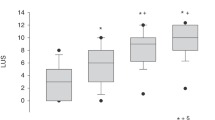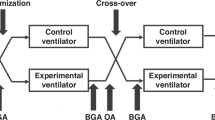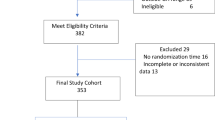Abstract
Extract: This study reports the effect of varying specific parameters of mechanical ventilation on aortic PO2 in six infants with severe respiratory distress syndrome. Twenty-seven studies were performed during the first 168 hours of mechanical ventilation. In each study, arterial oxygen partial pressure was found to vary directly with airway pressure and inversely with respiratory rate. No correlation was found between rate and pressure, or PaO2, PaCO2, and pHa. Oxygenation of infants with severe respiratory distress syndrome can be significantly influenced by variation of specific parameters of mechanical ventilation independently of change in aortic carbon dioxide tension.
Speculation: Optimal oxygenation during mechanical ventilation of infants with severe respiratory distress syndrome is dependent upon selection of the specific and appropriate pattern of ventilation.
Similar content being viewed by others
Log in or create a free account to read this content
Gain free access to this article, as well as selected content from this journal and more on nature.com
or
Author information
Authors and Affiliations
Rights and permissions
About this article
Cite this article
Smith, P., Daily, W., Fletcher, G. et al. Mechanical Ventilation of Newborn Infants I. The Effect of Rate and Pressure on Arterial Oxygenation of Infants with Respiratory Distress Syndrome. Pediatr Res 3, 244–254 (1969). https://doi.org/10.1203/00006450-196905000-00009
Issue date:
DOI: https://doi.org/10.1203/00006450-196905000-00009
Keywords
This article is cited by
-
Neonatal ventilation data: finding insight in chaos, or the new Hubble telescope
Pediatric Research (2021)



